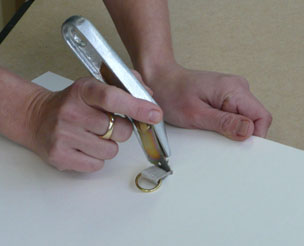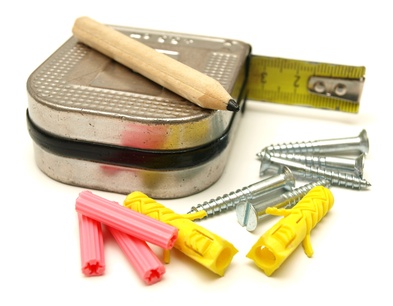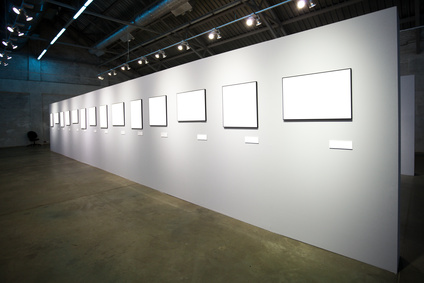Hanging, lighting, positioning, arranging in groups or alone… Everything you need to know about the main techniques for highlighting one or more works of art.

1. Preparing a framed work
Framed artwork usually comes with one or several hanging rings, attached to the backing board by means of a linen tape.
- One ring is enough for small works of art.
- For frames that are 30 x 40 cm or larger, plan on using at least two hanging rings.
- When hanging heavier objects, it is better to use screw type hanging rings or small round rings, screwed directly into the frame.
Please note! The the heavier the work, the stronger the material should be : linen cord, hanging wire, metal chain.

2. Hanging a picture
- The simplest method : slip the ring on the back of the frame onto a picture hanger nailed into the wall. Be sure you have wall hangers suited to the type of wall: nylon for solid wall materials (concrete, stone…) and expansion for hollow walls (dry wall, hollow core brick). On wooden surfaces you may use nails or picture hangers.
- It may be better to use an X hook instead of a picture hanger: metal feet with a hook on the one side, with an opening on the other side to allow one or more prongs to enter. There are many different kinds : choose them according to the type of wall and the weight of the frame.
- One picture hanger is usually enough. If the picture is very heavy, and the wall is fragile, it would be wise to use two picture hangers.
A closer look at : Picture rails
- Art gallery owners and amateurs alike use picture rails for their practicality. A grooved track, hung horizontally where the wall meets the ceiling, supports one or more vertical metal rods (picture rails). Pictures can then be hung on adjustable hooks which lock onto the hanging rods.
- Another option : hang your frames with picture wire or linen cord. the great advantage of this method is its flexibility : you may change your decor in the wink of an eye without having to repair bothersome holes!
Special hint: hang small pictures on a centered hanging rod and add one or more hanging rods to hang even more pictures. Aesthetics, hanging in a triangle consists of anchoring two points, set to either side of de picture, in one point of the triangle.

3. Lighting paintings
Except for oil and acrylic paintings, which benefit from the yellow luminosity of incandescent bulbs, most paintings should be lit by low wattage or LED bulbs.
- Avoid using halogen bulbs, which emit a high level of UV rays. Avoid also direct natural lighting, which damages paint: never hang a painting directly opposite a window!
- Spot lights, lighting strips and other types of light fixtures can be used; on the floor, the ceiling, hung from the picture rail, or even from the frame, above or below the painting. Using battery operated light fixtures will prevent the need for running yards and yards of electrical cords…

4. Arranging paintings
- Large paintings will, by their very presence, overwhelm more modestly sized paintings that you might be tempted to hang near them. Hang large paintings by themselves, in the middle of a bare wall, for example.
- On the other hand, medium and small pictures can easily be arranged in different configurations. These haphazard arrangements are nevertheless far more organized than they may appear. Even though they are composed of paintings of various shapes and sizes, the arrangement should on the whole ressemble an identifiable form : square, rectangle, oval…
- Do not feel that you have to limit yourself to hanging together only pictures of one type, be they engravings, oils or pastels. One cardinal rule : the whole arrangement should be harmonious, as though each picture had been created to coexist with the others.
- Try out several different arrangements on the floor before moving on to actually hanging your pictures.
- Unless two particular paintings were created to be hung together, generally it is better to avoid hanging pictures in pairs. Instead, favor groups of three, four, six… or more.
- Any grouping of frames of identical size, whether horizontal or vertical, must be hung the same distance apart. In a staircase, a series hung on the diagonal must match the pitch of the handrail.
- If you are hanging frames of different sizes, place the largest ones on the ends of the grouping.
- In a passage way (such as a hallway), hang pictures at eye level.
Tip: Paintings hung flat against the wall, or tilted forward ?
It's a matter of taste. In a grouping, all paintings must be slanted to the same degree.
- A painting hung at the top of an arrangement will more easily capture attention if it is hung at a slightly downward tilt (top of the frame away from the wall).
- A frame sitting on the floor will naturally tilt upwards… as if to better "look at" its observers.
Recommended product:
Mi-Teintes® mount boards
